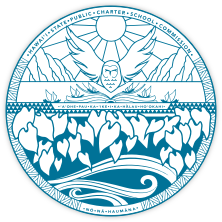HONOLULU, HI – The Executive Office on Early Learning and the Hawaiʻi State Public Charter School Commission’s prekindergarten programs were recognized for meeting 10 of the 10 high quality standard benchmarks identified by the National Institute for Early Education and Research (NIEER). The national ranking for these benchmarks is part of NIEER’s annual State Preschool Yearbook that was released Wednesday. Hawaiʻi is one of only five states to meet all 10 benchmarks.
SPCSC Interim Executive Director PJ Foehr said, "We are proud of the work our team has done in helping to create high-quality early learning opportunities for Hawaiʻi's families. From our beginning with the Preschool Development Grant, through our brief partnership with EOEL to our statutorily approved Charter School Early Learning Program, our team has worked tirelessly to support early learning classrooms and the staff that show up everyday to provide instruction for our littlest students. This NIEER report is a reflection of the efforts of many people across the state of Hawaiʻi. We look forward to continuing this work and being an active participant in the important work of early childhood education!"
“We are proud of the EOEL Public Prekindergarten Program and continued achievement of 10 out of 10 quality standard benchmarks. The ability to do this is a testament to the partnerships we continue to maintain and build with Department of Education schools and educators, with UH Mānoa College of Education, with the State Legislature and more,” said EOEL Director Yuuko Arikawa-Cross. “Our office continues to prioritize our collective work in fostering each child’s optimal growth and learning by ensuring that our educators, families, and most importantly, students are supported, especially during a time when Hawaiʻi’s vision for expanded access to early learning opportunities comes to fruition.”
Lt. Governor Sylvia Luke has made early learning one of her office priorities and leads the state’s preschool expansion plan, Ready Keiki. “I’m proud of the charter and public preschools across our state for their steadfast commitment to helping our keiki thrive,” said Luke. “This is truly a huge win as we continue prioritizing preschool expansion so that all three- and four-year-olds in Hawaiʻi have the support they need to grow and succeed.”
WHAT’S NEW
In the 2021-2022 school year, most Hawaiʻi State Public Charter Schools elected to enroll their pre-K classrooms to their enrollment capacity and provided flexibility in the use of virtual instruction as needed due to COVID-19. In-person instruction, though, predominated throughout the year. For EOEL classrooms, all were at reduced capacity during the 2021-2022 school year and all offered in-person instruction exclusively.
The Hawaiʻi State Legislature, through Act 257, Sessions Laws of Hawaiʻi 2022, has appropriated $200 million for the School Facilities Authority to add or expand access to prekindergarten for eligible children across the state for the fiscal year 2022-2023. In January 2023, Hawaiʻi was awarded a federal Preschool Development Grant Birth through Five (PDG B–5) renewal grant for $6.6 million. The University of Hawaiʻi Systems is the lead in this grant.
BACKGROUND
In Hawaiʻi, the Executive Office on Early Learning (EOEL) Public Prekindergarten Program serves four-year-old children, with priority given to students considered to be “at-risk,” including those from families at 300% or below of the Federal Poverty Level. The EOEL Public Prekindergarten Program is required to operate on the same schedule as public elementary schools, providing services for 1,080 hours a year.
Beginning in SY 2020-2021, through Act 46, SLH 2020, the legislature gave statutory authority to the State Public Charter School Commission to administer the early learning program in charter schools. Act 46, SLH 2020 also changed the eligibility criteria to include both three- and four-year-old children. No other priority categories were defined. Likewise, the early learning programs in charter schools are required to operate on the same schedule as their K-6 students.
State-funded public preschool partially recovered last year from the negative impacts of the COVID-19 pandemic nationally, and in Hawaiʻi. More importantly, Hawaiʻi now has a plan to serve all three- and four-year-olds by 2032. Eleven new classrooms are planned for 2023 and an additional 80 new classrooms are planned for 2024. Hawaiʻi is one of several states addressing longstanding problems in early education across the country that have persisted as preschool access remained below pre-pandemic levels, funding was inadequate, and quality standards failed to improve, according to the 2022 State of Preschool Yearbook, released Wednesday by Rutgers University’s National Institute for Early Education Research (NIEER).
KEY FINDINGS
For School Year 2021-2022 are summarized below for Hawaiʻi:
Enrollment in state-funded preschool was 549, an increase of 158;
State spending for preschool programs was $6,912,020, a decrease of $2,630,313 (inflation adjusted);
State spending per child enrolled in preschool was $12,590;
- Hawaiʻi met 10 of 10 quality standards benchmarks. The benchmarks include:
Early Learning and Development Standards (ELDS)
Curriculum supports
Teacher degree
Teacher specialized training
Assistant teacher degree
Staff professional development
Maximum class size (20)
Staff-child ratio (1:10).
Screenings and referrals
State requirements regarding a Continuous Quality Improvement System (CQIS).
Hawaiʻi has committed to working towards universal preschool for three- and four-year-olds;
Hawaiʻi did not provide incentives for preschool teacher retention or recruitment.
The new report found substantial year-over-year progress in enrollment nationally with a 13% increase of children in state-funded preschool in 2021-2022 with 180,668 more preschoolers enrolled than in the prior school year, and growth in nearly every state.
HAWAII: 2022 NATIONAL RANKINGS
Enrollment at age 4: 45th (3%)
Enrollment at age 3: 32nd (0.4%)
State spending per child: 4th ($12,590)
All-reported spending per child: 4th ($12,590)

